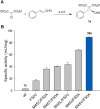Biocatalytic Asymmetric Cyclopropanations via Enzyme-Bound Iminium Ion Intermediates
- PMID: 34490955
- PMCID: PMC8596749
- DOI: 10.1002/anie.202110719
Biocatalytic Asymmetric Cyclopropanations via Enzyme-Bound Iminium Ion Intermediates
Abstract
Cyclopropane rings are an important structural motif frequently found in many natural products and pharmaceuticals. Commonly, biocatalytic methodologies for the asymmetric synthesis of cyclopropanes rely on repurposed or artificial heme enzymes. Here, we engineered an unusual cofactor-independent cyclopropanation enzyme based on a promiscuous tautomerase for the enantioselective synthesis of various cyclopropanes via the nucleophilic addition of diethyl 2-chloromalonate to α,β-unsaturated aldehydes. The engineered enzyme promotes formation of the two new carbon-carbon bonds with excellent stereocontrol over both stereocenters, affording the desired cyclopropanes with high diastereo- and enantiopurity (d.r. up to 25:1; e.r. up to 99:1). Our results highlight the usefulness of promiscuous enzymes for expanding the biocatalytic repertoire for non-natural reactions.
Keywords: biocatalysis; catalytic promiscuity; cyclopropanation; enzyme engineering.
© 2021 The Authors. Angewandte Chemie International Edition published by Wiley-VCH GmbH.
Conflict of interest statement
The authors declare no conflict of interest.
Figures


Similar articles
-
An Enzymatic Platform for the Highly Enantioselective and Stereodivergent Construction of Cyclopropyl-δ-lactones.Angew Chem Int Ed Engl. 2020 Nov 23;59(48):21634-21639. doi: 10.1002/anie.202007953. Epub 2020 Sep 17. Angew Chem Int Ed Engl. 2020. PMID: 32667122 Free PMC article.
-
Biocatalytic Strategy for the Highly Stereoselective Synthesis of CHF2 -Containing Trisubstituted Cyclopropanes.Angew Chem Int Ed Engl. 2021 Mar 22;60(13):7072-7076. doi: 10.1002/anie.202015895. Epub 2021 Feb 17. Angew Chem Int Ed Engl. 2021. PMID: 33337576 Free PMC article.
-
Gram-Scale Synthesis of Chiral Cyclopropane-Containing Drugs and Drug Precursors with Engineered Myoglobin Catalysts Featuring Complementary Stereoselectivity.Angew Chem Int Ed Engl. 2016 Dec 23;55(52):16110-16114. doi: 10.1002/anie.201608680. Epub 2016 Nov 25. Angew Chem Int Ed Engl. 2016. PMID: 27885768 Free PMC article.
-
Navigating the Unnatural Reaction Space: Directed Evolution of Heme Proteins for Selective Carbene and Nitrene Transfer.Acc Chem Res. 2021 Mar 2;54(5):1209-1225. doi: 10.1021/acs.accounts.0c00591. Epub 2021 Jan 25. Acc Chem Res. 2021. PMID: 33491448 Free PMC article. Review.
-
Exploiting and engineering hemoproteins for abiological carbene and nitrene transfer reactions.Curr Opin Biotechnol. 2017 Oct;47:102-111. doi: 10.1016/j.copbio.2017.06.005. Epub 2017 Jul 13. Curr Opin Biotechnol. 2017. PMID: 28711855 Free PMC article. Review.
Cited by
-
Designing Enzymatic Reactivity with an Expanded Palette.Chembiochem. 2025 Jun 3;26(11):e202500076. doi: 10.1002/cbic.202500076. Epub 2025 Apr 4. Chembiochem. 2025. PMID: 40183295 Free PMC article. Review.
-
Unlocking New Reactivities in Enzymes by Iminium Catalysis.Angew Chem Int Ed Engl. 2022 Jul 25;61(30):e202203613. doi: 10.1002/anie.202203613. Epub 2022 Jun 15. Angew Chem Int Ed Engl. 2022. PMID: 35524737 Free PMC article. Review.
-
Organocatalytic enantio- and diastereoselective assembly of cyclopropane-incorporated polycyclic molecules via isobenzopyrylium ions.Chem Sci. 2024 Aug 22;15(37):15274-9. doi: 10.1039/d4sc03746d. Online ahead of print. Chem Sci. 2024. PMID: 39246368 Free PMC article.
-
Multifunctional Biocatalysts for Organic Synthesis.J Am Chem Soc. 2024 Mar 27;146(12):7876-7884. doi: 10.1021/jacs.3c09542. Epub 2024 Mar 15. J Am Chem Soc. 2024. PMID: 38489244 Free PMC article. Review.
-
Enhancing the Peroxygenase Activity of a Cofactor-Independent Peroxyzyme by Directed Evolution Enabling Gram-Scale Epoxide Synthesis.Chemistry. 2022 Oct 21;28(59):e202201651. doi: 10.1002/chem.202201651. Epub 2022 Aug 26. Chemistry. 2022. PMID: 35861144 Free PMC article.
References
Publication types
MeSH terms
Substances
Grants and funding
LinkOut - more resources
Full Text Sources

